Anatomy - integumentary system
5.0(1)
Card Sorting
1/53
Earn XP
Description and Tags
Study Analytics
Name | Mastery | Learn | Test | Matching | Spaced |
|---|
No study sessions yet.
54 Terms
1
New cards
What does it consist of
Skin and accessory structures: hair, glands and nails
2
New cards
Functions of skin:
Protection, sensation, vitamin d production, temp regulation and excretion
3
New cards
Three layers:
Epidermis, dermis, hypodermis
4
New cards
Three layers of epidermis layer:
Stratum corneum, intermediate strata, stratum basale
5
New cards
Stratum corneum function
Dead squamous cells with keratin
6
New cards
Intermediate strata function:
Cuboidal cells become squamous
7
New cards
Stratum basale function:
Mitotic division every 19 days
8
New cards
Keratinization
New cells being formed, pushing old cells toward the surface where they become hard, dead cells
9
New cards
Melanin is a …
Pigment
10
New cards
Melanocytes
Cells that produce melanin
11
New cards
Melansomoes
Package melanin and transfer it to the epithelium
12
New cards
Eumelanin
Black/brown pigment
13
New cards
Pheomelanin
Red/yellow pigment
14
New cards
Things that effect skin color:
Blood flow, exposure to uv rays, hormones, genetics
15
New cards
Difference between thick and thin skin
Thick skin has more keratinized cells in the epidermis layer
16
New cards
Dermis contains and usage:
Dense collagenous connective tissue, fingerprints and stretch marks
17
New cards
Thick skin location:
Palm and feet
18
New cards
Hypodermis contains and usage:
Loose connective tissue (adipose), foundation for skin, padding and insulation
19
New cards
Hair follicles structures and roles:
Follicle: extension of dermis
Shaft: above skin, medulla/cortex/cuticle
Bulb: were hair and melanin are produced
Arrector pili: smooth muscle that causes goose bumps
Shaft: above skin, medulla/cortex/cuticle
Bulb: were hair and melanin are produced
Arrector pili: smooth muscle that causes goose bumps
20
New cards
Sebaceous glands function:
Not a sweat gland
Produce and secrete oily substance that is rich in lipids to keep structures hydrated
Lubricates hair and surface of skin using sebum
Produce and secrete oily substance that is rich in lipids to keep structures hydrated
Lubricates hair and surface of skin using sebum
21
New cards
Eccrine sweat glands functions:
Not tied to hair follicles
Used to cool body - sweat
Most located in palms and feet
Used to cool body - sweat
Most located in palms and feet
22
New cards
Aprocrine sweat glands functions:
Odors
Only founds in armpits and genitals
Become active at puberty
Secrets odorless substance that becomes bo when broken down by bacteria
Only founds in armpits and genitals
Become active at puberty
Secrets odorless substance that becomes bo when broken down by bacteria
23
New cards
Cutaneous receptors functions:
Sensory receptors found in the dermis
Sense pain, pressure, and temp.
Sense pain, pressure, and temp.
24
New cards
Types of cutaneous receptors:
Thermoreceptor - senses heat and cold
Meissner’s corpuscle. - senses touch
Nociceptor - senses. Pain
Pacinian corpuscle - senses pressure
Meissner’s corpuscle. - senses touch
Nociceptor - senses. Pain
Pacinian corpuscle - senses pressure
25
New cards
Hair shaft vs. hair root
Hair shaft is the top, visible part of the hair and the root is where hair comes out of, not visible.
26
New cards
Parts of the nail:
Body, root, cuticle, matrix, bed, lunula, and free edge
27
New cards
Nail body
Visible part
28
New cards
Nail root
Covered part
29
New cards
Cuticle
Stratum corneum that extends onto nail body
30
New cards
Nail matrix
Produces nail and is the epithelial tissue from stratum basale
31
New cards
Nail bed
Softer part under the nail
32
New cards
Lunula
Visible epithelial tissue (half circle)
33
New cards
Free edge
Top white part of nail
34
New cards
Partial vs. full thickness burns
Partial only burns through some of the skin layers, full burns through all layers.
35
New cards
Partial thickness burns
1st and 2nd degree
36
New cards
Full thickness burns
3rd degree
37
New cards
Physiological changes with full-thickness burns:
Less protection
Decrease in blood volume
Elevated temp and heart rate (hyper metabolic state)
Increased risk of infection
Decrease in blood volume
Elevated temp and heart rate (hyper metabolic state)
Increased risk of infection
38
New cards
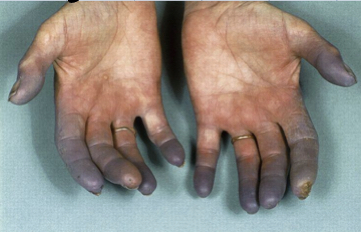
Cyanosis
Cut of blood flow to extremities, blue finger tips
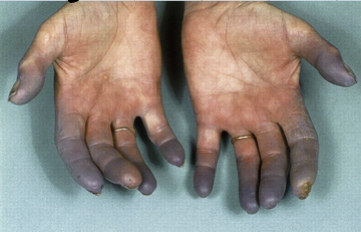
39
New cards
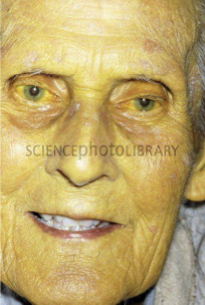
Jaundice
Liver damage - yellow skin

40
New cards

Scarlet fever
Hives all over body
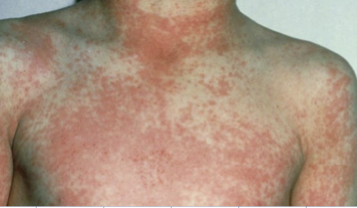
41
New cards
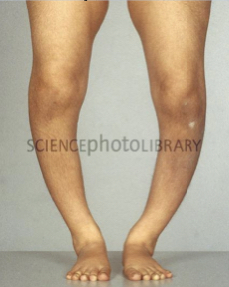
Rickets
Vitamin d deficiency
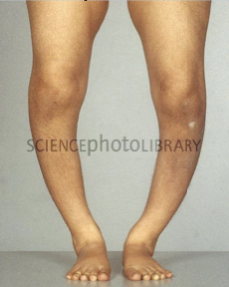
42
New cards
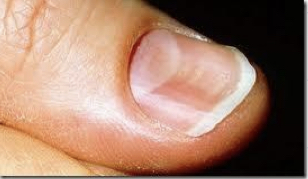
Iron deficiency anemia
No cuticle

43
New cards
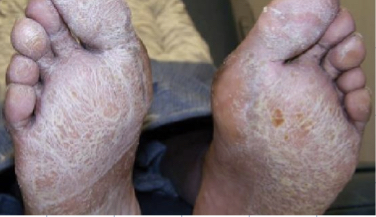
Vitamin a deficiency
Extremely dry skin
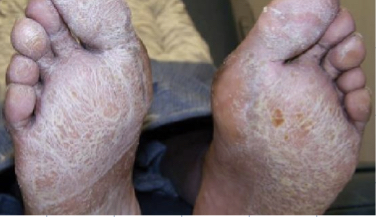
44
New cards
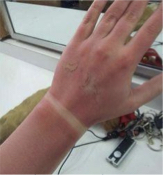
1st degree burns:
Only epidermis layer
Redness, pain and swelling
No scaring
Healing time: 1-2 weeks
Caused. By: sunburn or brief exposure to hot and cold surfaces
Redness, pain and swelling
No scaring
Healing time: 1-2 weeks
Caused. By: sunburn or brief exposure to hot and cold surfaces
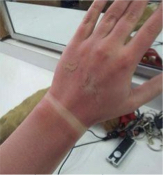
45
New cards
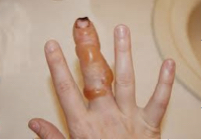
2nd degree burns
Burns through epidermis and dermis layers
Redness, swelling, pain and blisters
Healing time: 2 weeks - 2 months
Sometimes scares
Redness, swelling, pain and blisters
Healing time: 2 weeks - 2 months
Sometimes scares
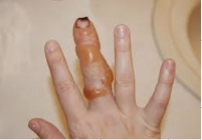
46
New cards
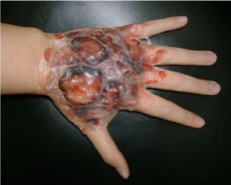
3rd degree burns
Burns through all layers
Appears all colors
Painless because it burns off pain receptors
Healing time: 1 or more years
Appears all colors
Painless because it burns off pain receptors
Healing time: 1 or more years
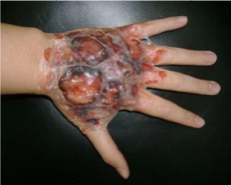
47
New cards
Three types of skin cancer
Basal cell carcinoma
Squamous cell carcinoma
Melanoma
Squamous cell carcinoma
Melanoma
48
New cards
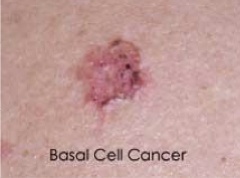
Basal cell carcinoma
Caused by uvb rays
Most common type of skin cancer
Starts in status basale and extents into dermis
Presents as open sore ro reddish patch
Treatment: removal or radiaition therapy
Most common type of skin cancer
Starts in status basale and extents into dermis
Presents as open sore ro reddish patch
Treatment: removal or radiaition therapy
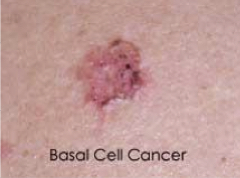
49
New cards

Squamous cell carcinoma
Located in the intermediate strata and status corneum
Continues to divide as keratin is produced
Can cause death if spreads into dermis
Caused by uvb rays
Presents as open sore
Continues to divide as keratin is produced
Can cause death if spreads into dermis
Caused by uvb rays
Presents as open sore

50
New cards
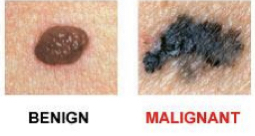
Melanoma
Caused by uva rays
Most deadly especially if it spreads to dermis
Caused my melanocytes in preexisting mole
Most deadly especially if it spreads to dermis
Caused my melanocytes in preexisting mole

51
New cards
ABCDEs
A-asymmetry
B-border irregularity
C-change in color
D-change in diameter (greater than 1/4 inch)
E-evolving
B-border irregularity
C-change in color
D-change in diameter (greater than 1/4 inch)
E-evolving
52
New cards
Malignant
Active
53
New cards
Metastasize
Spreading
54
New cards
Benign
Dorment